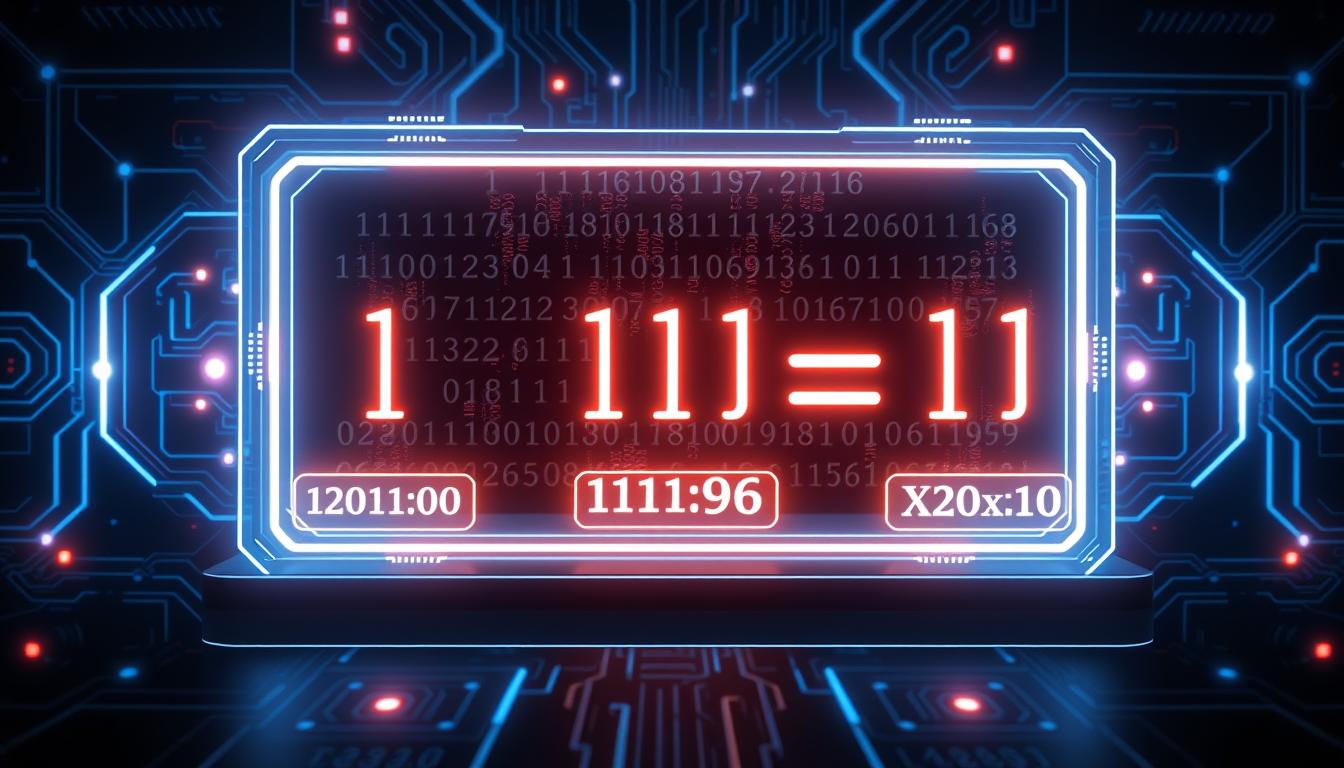Working with digital systems means you often need to switch between binary, decimal, and hexadecimal. A binary translator or tool makes this easy, saving you time. It lets you quickly switch between binary, decimal, and hexadecimal.
Both newbies and experts in digital systems need a binary conversion tool. It shows how different number systems work and makes conversions fast. It’s great for projects or learning computer science.
Using a binary translator or tool makes working with digital systems easier. You can switch between binary, decimal, and hexadecimal without hassle. It’s a must-have for anyone in digital tech.
Key Takeaways
- You can use a binary translator to convert between binary, decimal, and hexadecimal number systems.
- A binary conversion tool is user-friendly and easy to use.
- Converting binary to decimal or hexadecimal is a common task in computer science and digital technology.
- A binary translator can save you time and effort when working with digital systems.
- It’s an essential tool for both beginners and professionals working with digital systems.
- You can use a binary translator to work more efficiently with digital systems.
- A binary conversion tool helps you understand the relationship between different number systems.
Understanding Binary Code: The Language of Computers
When you start learning computer programming, you’ll soon learn about binary code. This language uses only two digits: 0 and 1. It’s the foundation of all computer operations. A binary code converter can make binary code easier to read, but first, let’s cover the basics.
The binary system relies on electronic circuits and Boolean logic. It uses binary digits (bits) to represent information. These bits combine to form bytes, which are the core of binary code. Binary code lets computers process information quickly and accurately, making it key to computer programming.
- Binary code consists of only two digits: 0 and 1.
- Electronic circuits and Boolean logic form the foundation of binary code.
- Bits and bytes are the basic units of binary code, with bytes being composed of multiple bits.
Learning about binary code will help you use a binary code converter better. It opens the door to the world of computer programming. Next, we’ll look at how a binary translator works and how it can make binary code easier to understand.
| Binary Code | Decimal Equivalent |
|---|---|
| 1010 | 10 |
| 1101 | 13 |
| 1001 | 9 |
How Your Binary Translator Works
Exploring binary translation is fascinating. It’s key to know how a binary to text converter works. This tool uses advanced algorithms to turn binary code into text we can read. It’s a must-have for programmers and developers.
Converting binary to text involves several steps. First, there’s data encoding and then decoding. The converter changes the binary code into something we can understand. You can find this tool online, like at binary translator.
Some important features of a binary to text converter are:
- Accurate conversion of binary code to text
- Support for large numbers and complex conversions
- User-friendly interface for easy input and output
Using a binary to text converter can make your work easier. It’s great for projects that need binary conversions or for decoding messages. This tool is a must-have.
A binary to text converter is a vital tool for anyone working with binary code. It helps you unlock the full potential of binary translation. This can take your projects to new heights.
| Feature | Description |
|---|---|
| Binary Conversion | Accurate conversion of binary code to text |
| Large Number Support | Support for large numbers and complex conversions |
| User Interface | User-friendly interface for easy input and output |
Converting Binary to Decimal Numbers
Working with binary code means knowing how to change binary numbers to decimal. This skill is key in many programming tasks. An online binary translator makes this easier. First, you need to grasp the basics of binary and decimal systems.
To convert, multiply each binary digit by the power of 2 it represents. Then, add up these products. For instance, 1010 in binary is 10 in decimal. This is done by calculating (1*2^3) + (0*2^2) + (1*2^1) + (0*2^0) = 8 + 0 + 2 + 0 = 10. An online translator can do this fast and right.
Step-by-Step Conversion Process
To change binary to decimal, follow these steps:
- Write down the binary number
- Identify the place value of each digit (powers of 2)
- Multiply each digit by its corresponding place value
- Sum the results
An online binary translator helps avoid mistakes. This includes not mixing up digits or wrong place values.
Common Conversion Mistakes to Avoid
When converting binary to decimal, watch out for mistakes. These can mess up your results. Common errors include getting digits mixed up, wrong place values, or forgetting zeros. Use an online translator and check your work to get it right.
Decimal to Binary Conversion Made Simple
Converting decimal numbers to binary is key in computer programming and digital design. A binary language converter makes this easier. You can divide the decimal number by 2 and note the remainders, or subtract powers of 2.
For quick mental tricks with small numbers, remember that 2^3 = 8 and 2^4 = 16. This helps in converting small decimal numbers to binary. Also, a binary language converter can help check your work for accuracy.
Knowing how to convert decimal to binary is vital for computer programming and digital design. It’s used in many areas like computer networking, cryptography, and data compression. With practice and a binary language converter, you can get better at this skill.
- Use the division method or subtraction method for conversion
- Practice quick mental conversions of small numbers
- Use a binary language converter to check conversions and ensure accuracy
Mastering decimal to binary conversion boosts your skills in computer programming and digital design. It opens up new opportunities in technology. A binary language converter simplifies the process, letting you tackle more complex tasks.
Understanding Hexadecimal Conversion
When you dive into binary and decimal conversions, you might see hexadecimal numbers. Hexadecimal is a base-16 system using 0-9 and A-F to show values. It’s great for computer coding and web design because it’s good at showing big binary numbers. A binary to decimal converter helps you see how these systems relate.
Hexadecimal is neat because each digit can be 16 different things. For instance, “A” is 10 in decimal, and “F” is 15. It’s super handy for web design, especially for color codes using RGB.
To switch between hexadecimal and binary, use a binary to decimal converter as a guide. Here’s how to do it:
- Change the hexadecimal to decimal
- Then, change the decimal to binary
Online tools or programming languages can make this easier. Knowing how to convert hexadecimal is key in many fields, like coding, web design, and data analysis.
| Hexadecimal | Decimal | Binary |
|---|---|---|
| A | 10 | 1010 |
| F | 15 | 1111 |
Learning hexadecimal conversion boosts your skills with binary and decimal numbers. It makes using a binary to decimal converter and exploring coding and web design easier.
Advanced Features of Binary Translation Tools
Exploring binary translation reveals tools with advanced features. These tools make translate binary to text tasks easier. One key feature is batch conversions, which let you convert many files at once. This saves a lot of time and effort.
Another important feature is support for different number bases, like octal. This is useful for programming languages that use unique number systems. Many tools also work well with programming environments, making it simple to add binary code to your projects.
Some of the advanced features of binary translation tools include:
- Batch conversions for multiple files
- Support for different number bases, such as octal
- Integration with programming environments
- Precision and error handling for advanced conversions
When working with binary code, precision and error handling are crucial. This is especially true for floating-point numbers or large integers. Using a tool with advanced features ensures accurate and reliable conversions.
By using these advanced features, you can translate binary to text more efficiently. Whether you’re a developer, data analyst, or digital designer, these tools help you work better and reach your goals.
Binary to Text Conversion: Understanding ASCII
Working with binary data often requires converting it into text we can read. ASCII (American Standard Code for Information Interchange) is key for this. You’ll learn how ASCII works and how to use it to turn binary strings into text.
To convert binary to text, we assign a unique binary code to each character. This code represents the character in the text. For instance, the letter “A” has the binary code 01100001. A binary string converter makes it easy to switch between binary and text.
ASCII Code Basics
ASCII code is a standard that gives each character a unique binary code. It includes letters, numbers, and special characters. To convert binary to text, you look up the binary code for each character in an ASCII table.
Converting Text Messages
Converting text from binary involves using a binary string converter to find the right ASCII code for each character. You can do this manually with an ASCII table or use a tool. Either way, you get a text message that’s easy for humans to read.
When converting text, remember to handle special characters and control codes right. They have unique binary codes that must be interpreted correctly. A good binary string converter ensures your text messages are accurate and clear.
Common Applications for Binary Translation
Exploring binary translation opens up its importance in many fields. A binary translator is key for those in computer networking. It helps analyze packet data for smooth device communication. In digital signal processing, it converts analog signals to digital, making them easier to process.
In cryptography, it keeps data safe by turning plain text into unreadable ciphertext. Data compression also uses it to shrink file sizes. This makes files transmit and store faster. You can use a binary translator to see how these work.
- Computer networking: analyzing packet data and ensuring network security
- Digital signal processing: converting analog signals to digital formats
- Cryptography: securing data through encryption and decryption
- Data compression: reducing file sizes for efficient transmission and storage
As tech evolves, binary translation’s role will grow. It’s becoming more important in quantum computing and blockchain. Knowing how a binary translator works in these areas helps you understand the digital world better. It opens doors to new innovations and growth.
Troubleshooting Your Binary Conversions
Working with binary conversions requires a reliable tool for accuracy. A binary conversion tool can help verify your work and find any mistakes. This ensures your conversions are correct.
To fix your binary conversions, first check your work for errors. Use reverse checking to convert the binary code back to its original form. This way, you can see if it matches the original data. It helps find any mistakes made during the conversion.
Verification Methods
There are several ways to check if your binary conversions are right. You can:
- Use different conversion tools to compare your results
- Look for parity bits and checksum algorithms to spot errors
- Go through the conversion step by step to catch any mistakes
These methods help make sure your binary conversions are correct and trustworthy. A good binary conversion tool can make this process easier and lower the chance of mistakes.
Error Detection
Finding errors in binary conversions is key. You can use techniques like parity bits and checksum algorithms to spot mistakes. By fixing these errors, you can make sure your binary conversions are accurate and reliable.
Tips for Efficient Binary Code Translation
Working with binary code can be easier with a good binary code converter. Learning quick conversion tricks and common binary patterns can help a lot. This makes complex conversions easier to handle.
Knowing how number systems work is key for fast and easy translations. It helps you feel more confident when dealing with tough conversions. Keeping your work organized is also important, especially if you work with binary often. Use a standard way of writing and keep track of your work.
Here are some tips for better binary code translation:
- Mastering common binary patterns and shortcuts
- Developing mental math tricks for quick conversions
- Understanding the underlying principles of number systems
- Implementing a standardized notation system
- Maintaining a record of conversions
Using these strategies can make your work with binary code faster and more accurate. Whether you use a binary code converter or do conversions by hand, these tips will help you do better.
Conclusion: Mastering Binary Translation for Practical Use
This guide has shown you how to translate between binary, decimal, and hexadecimal systems. Learning to use a binary translator is key in today’s digital world. It helps you understand how computers and digital tech work.
You now know how to work with binary code and convert numbers accurately. This skill is useful for programmers, tech fans, and anyone curious about digital systems. The binary translator is a powerful tool for exploring and understanding digital concepts.
Keep practicing with the binary translator and dive into the world of binary, decimal, and hexadecimal conversions. As tech advances, the need for people skilled in these areas will increase. By improving your binary translation skills, you’ll be ready for the digital future.
Mastering binary translation is a continuous journey. With hard work and a desire to learn, you can grasp the digital world better. Face the challenges, try new things, and let your curiosity lead you. This journey is both rewarding and enlightening.




